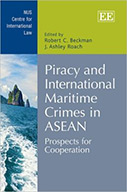Piracy And International Maritime Crimes In Asean:
Prospects for Cooperation

Editors: Robert C. Beckman , J. Ashley Roach
Publisher: Edward Elgar, 2012. 272p.
Reviewer: Leonid Lantsman | November 2013
In Piracy and International Maritime Crime in ASEAN, Robert C. Beckman and J. Ashley Roach (Eds.) survey the current state of maritime piracy in Southeast Asia and the viability of various regional and international legal mechanisms to address it. The importance of security in Southeast Asian waterways for the unencumbered flow of global trade cannot be overstated. Over 60,000 vessels transit through these waters at the Straits of Malacca, which at one point narrows to 1.5 miles at the Philips Channel south of Singapore1. Numerous regional and non-regional states heavily rely on secure passage for cargo vessels to provide significant proportions of traded goods and essential supplies such as petroleum and other natural resources. China, for example, depends on the Malacca Straits for 85% of its imports, including 80% of its energy imports.
While the Association of South East Asian Nations (ASEAN) could theoretically provide an integrated regional foundation to address maritime piracy, historically ASEAN’s primary purpose has been to facilitate trade and increase economic cooperation among member states2. ASEAN’s loosely integrated structure and the widely disparate positions of member states preclude a facile approach to address piracy in the region. Furthermore, ASEAN member states have serious concerns regarding sovereignty and as a result, the ratification and implementation of international legal instruments has met headwinds in numerous ASEAN states. The contributors of this volume address ASEAN’s weaknesses and point to a variety of mechanisms to use ASEAN’s structure while incorporating international law to address maritime piracy in the region.
By framing the discussion within the global foundation for addressing maritime piracy, the United Nations Convention on the Law of the Sea (UNCLOS), the authors are able to focus on highlighting the deficiencies in both UNCLOS’s provisions and ASEAN’s structure that lead to the difficulty in prosecution and cooperation to address piracy in the region. As Robert Beckman describes in Chapter 1, UNCLOS does not require state parties to ratify or enact legislation to address maritime piracy. Furthermore, according to the convention, piracy can only occur on the high seas or in a state’s exclusive economic zone and for private gain. Most piracy incidents in Southeast Asia occur within the state’s territorial waters and therefore do not qualify as piracy under UNCLOS. Other incidents such as hijacking of the Achille Lauro, laid bare the limitations when the crime was a politically motivated act. To address those limitations, J. Ashley Roach describes how the 1979 Hostages Convention and the 1988 Convention for the Suppression of Unlawful Acts Against the Safety of Maritime Navigation (1988 SUA), in tandem with UNCLOS, could provide a strong foundation to address piracy incidents on the high seas and also within territorial waters and port or land-side incidents.
Nikos Passas and Anamika Tyman-Ghoshal focus on the 1999 Financing of Terrorism Convention, the 2000 U.N. Convention on Transnational Organized Crime and the 2003 U.N. Convention against Corruption. While UNCLOS, the 1979 Hostages Convention and the 1988 SUA Convention, focus on providing jurisdiction to prosecute incidents of piracy, or defining piracy itself, Passas and Tyman-Ghoshal identify how instruments that are used to combat money laundering and tax offenses may be applied to combat the financial flows stemming from piracy incidents.
The financial implications of incidents in South East Asia can be manifold especially as criminal groups have resorted to more complex and large piracy incidents. As Karsten von Hoesslin notes, Southeast Asian incidents include serious incidents of vessel theft, primarily thefts of tug vessels of which there have been six incidents from 2008 through 2012, and numerous small scale incidents of cluster robbery and intimidation of vessels land-side. This is in marked contrast to Somali piracy. While piracy off the coast of Somalia may be financially lucrative, typically it does not lead to the re-sale of stolen vessels. Rather, the piracy primarily involves vessel ransom, though this is a small subsection of incidents in South East Asia as well. Less lucrative is piracy in the Bight of Benin in West Africa, where most incidents are small-scale armed robberies or burglaries from vessels, and have neither the level of sophistication of some Southeast Asian piracy incidents nor employ the heavy use of arms used by Somali groups.
While global conventions offer a possible framework to address maritime piracy, there are myriad contextual and political reasons as to why they have thus far failed to produce the necessary framework to address piracy in ASEAN states. Robert Beckman notes that within the context of the civil, common and hybrid legal traditions of disparate ASEAN member states, the conventions discussed above face an array of challenges. Foremost among the obstacles to ratification and implementation are jurisdictional and legislative voids that allow criminal groups to operate with near impunity. Coupled with a lack of political will to tackle piracy, ASEAN states have faced a difficult time addressing piracy through global conventions. For example, one of the primary mechanisms to combat piracy in the region, the 2004 Regional Cooperation Agreement on Combating Piracy and Armed Robbery against Ships in Asia (ReCAAP) has yet to be signed or ratified by two key states, Malaysia and Indonesia — both citing concerns over sovereignty. On an operational level, concerns of sovereignty may be less of an issue. This can be witnessed in the operational cooperation among Malaysia, Singapore and Indonesia through the MALSINDO agreement, where the lack of state will to conduct full scale operations has hindered operational success more than concern over sovereignty intrusion of regional cooperative instruments.
Termsak Chalermpalanpap and Mayla Inbanez focus on ASEAN’s tangible efforts to address maritime piracy through regional conventions, specifically the 2004 Treaty on Mutual Legal Assistance in Criminal Matters (2004 MLAT) and the 2007 ASEAN Convention on Counter-Terrorism (2007 ACCT). These measures provide ASEAN states with enforcement capability to address terrorism and provide assistance for cross-border investigations; however, the lack of political will has enabled piracy to yet be defined within the purview of these conventions when there are strong arguments in favor of its inclusion. On cross-border cooperation, Cheah Wui Ling provides a comparative overview of the conventions detailed above and their strengths and weaknesses with regards to the investigation of piracy incidents. She concludes that the various instruments overlap significantly when addressing piracy, as they were often developed in response to specific policy problems and taken together can form an ad-hoc approach to combating piracy. The enforcement capabilities of these global and regional instruments provide a multitude of methods for an ASEAN member state to prosecute and investigate a piracy incident. States, however, continue to exercise discretion in deciding to address whether they have jurisdiction in specific piracy incidents primarily due to concerns about sovereignty.
The authors in this volume tackle a complex and multifarious subject. As such, the volume provides an engaging way to introduce scholars of and scholarship on piracy and maritime crime into the legal environment created by global and regional instruments to combat piracy and their implications for the South East Asian context. That it is even possible to discuss legal recourses to address piracy in this region is a positive development, when compared with the ongoing use of naval and land forces that are currently addressing piracy in the western Indian Ocean. The continued recourse to the rule of law to address piracy through global and regional legal instruments is a positive step towards institutionalizing the adjudication of maritime crime in South East Asia; and, doing so within the letter of the law and not at the barrel of a cannon.
Leonid Lantsman is a Franklin Fellow at the U.S. Department of State. These views are his own and do not represent those of the Department of State or the United States Government.
___________________________________
2 Brunei Darussalam, Cambodia, Indonesia, Laos, Malaysia, Myanmar, Philippines, Singapore, Thailand and Vietnam


